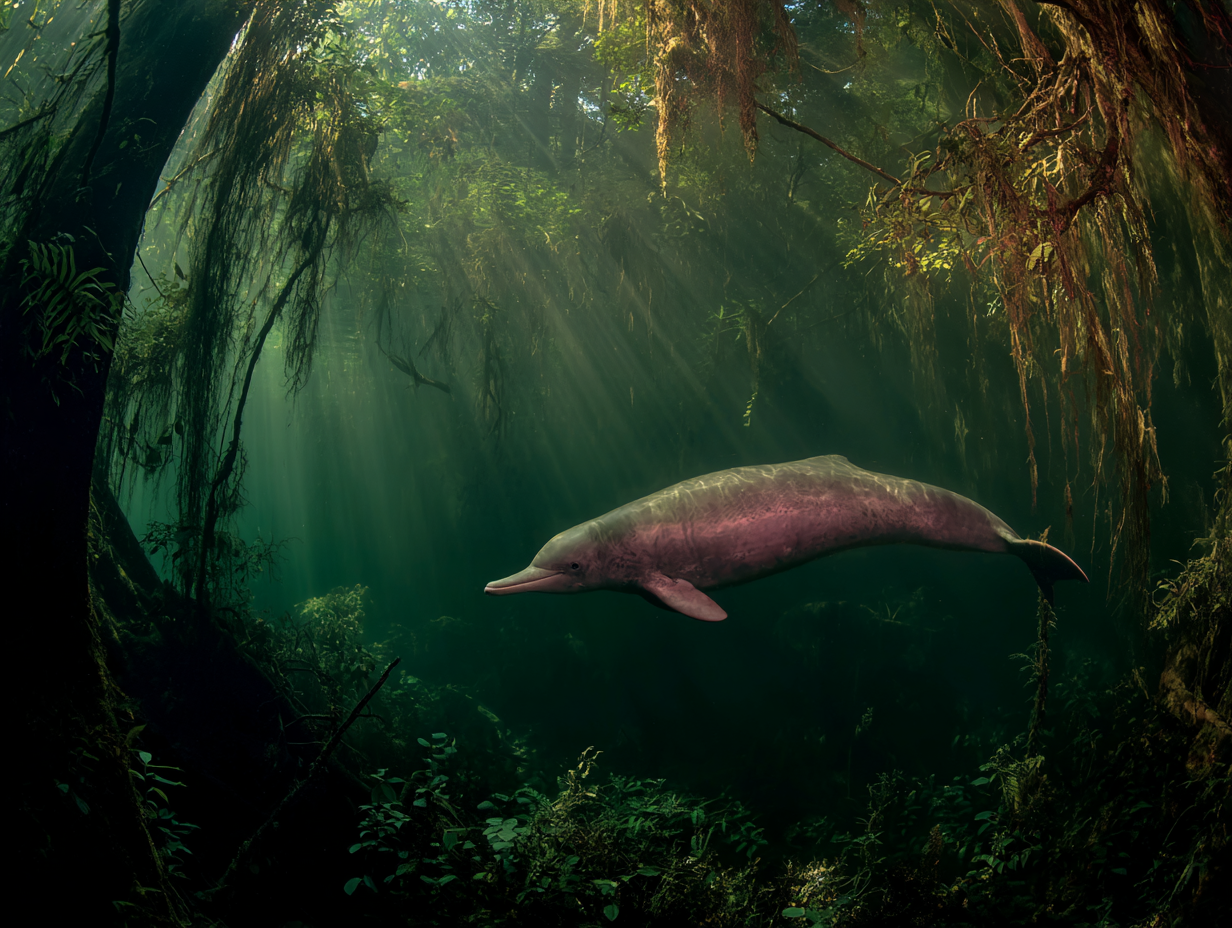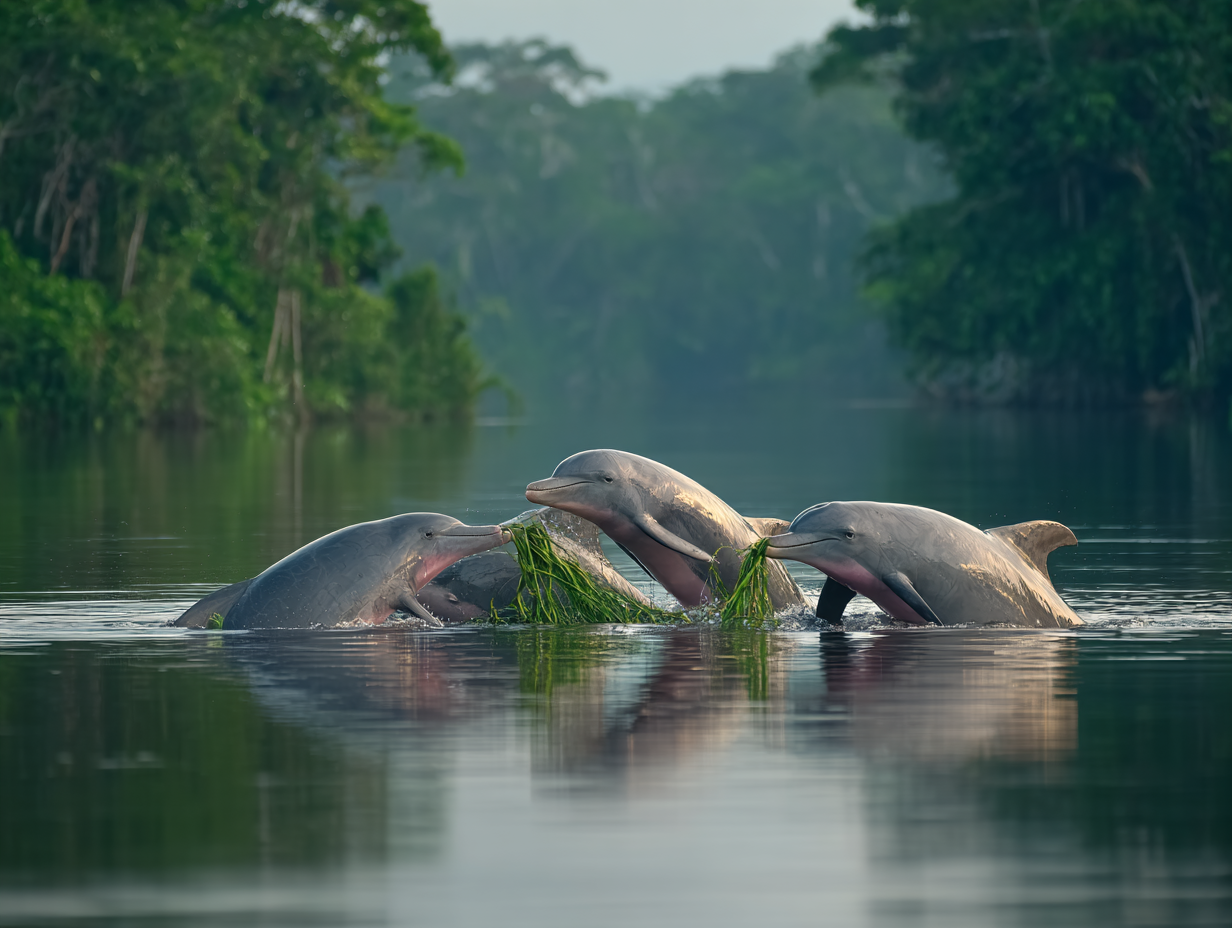Amazon River Dolphin
The Enchanted Dolphin of the River
The Amazon River Dolphin—known throughout its vast range as the boto, bufeo, or simply "pink dolphin"—is one of the world's most enigmatic cetaceans. Dwelling in the murky, labyrinthine waterways of the Amazon and Orinoco basins, it is the largest of the river dolphins and one of only a handful of cetacean species that has adapted to live exclusively in freshwater. Its distinctive pink coloration in adult males, its unfused neck vertebrae allowing extraordinary head mobility, and its long, slender rostrum filled with conical teeth all speak to a life lived in one of the most biologically complex and challenging aquatic environments on Earth.
For Indigenous peoples of the Amazon, the boto has long been wrapped in myth and magic. In many communities, it was traditionally considered taboo to harm these dolphins, as they were believed to possess supernatural powers—shape-shifters that could transform into handsome men or beautiful women to seduce the unwary. These protective cultural beliefs may have historically shielded the species from harm, but in the last two decades, that protection has tragically crumbled.

The distinctive pink coloration and elongated rostrum of an adult male boto.
Physical Characteristics
Adult Amazon River Dolphins range from 6.5 to 8.5 feet (2 to 2.6 meters) in length, with males reaching up to 408 pounds (185 kg)—making them significantly larger and heavier than females. This sexual dimorphism is pronounced, with males also displaying more vibrant pink coloration. Newborn calves are dark grey, gradually lightening as they mature.
Why Pink?
The boto's distinctive pink color results from a combination of superficial capillaries close to the skin surface and the accumulation of scar tissue from aggressive encounters. The more social interactions and fights a male experiences, the pinker he becomes—making coloration a potential indicator of dominance and reproductive success.
The boto possesses several remarkable adaptations for life in the flooded forest. Its rostrum—long, slender, and lined with 25-28 pairs of conical teeth on each jaw—is perfectly designed for capturing fish hiding among submerged vegetation and tree roots. Unlike oceanic dolphins, the boto has unfused cervical vertebrae, allowing it to turn its head up to 180 degrees relative to its body. This extraordinary flexibility is essential for hunting in the three-dimensional maze of the seasonally flooded rainforest.
The boto's eyes are small and positioned laterally—an adaptation to the perpetually murky waters where vision is of limited use. Instead, it relies heavily on echolocation, emitting clicks that bounce off prey and obstacles to create a detailed acoustic map of its surroundings. Its pectoral flippers are large and paddle-like, providing exceptional maneuverability in confined spaces.

A boto navigates the labyrinthine underwater world of the seasonally flooded forest—its unfused neck vertebrae allowing 180-degree head rotation to hunt among submerged trees and roots.
A Life in the Flooded Forest
The Amazon River Dolphin is a creature perfectly sculpted by its environment. Its most remarkable anatomical feature is its unfused cervical vertebrae—a trait unique among dolphins that allows it to turn its head a full 180 degrees relative to its body. This extraordinary flexibility is essential for navigating the complex, three-dimensional underwater labyrinth of the seasonally flooded forest, where it hunts for prey among submerged trees and roots.
Diet and Foraging
With one of the most varied diets among all toothed whales, the boto consumes at least 53 different species of fish, including piranhas. Its heterodont dentition—different types of teeth for different functions—also allows it to eat hard-shelled prey like freshwater crabs and small turtles. In the murky waters of the Amazon, it relies heavily on echolocation to hunt, emitting clicks that bounce off prey and return as echoes.
Social Structure and Behavior
The boto's social structure is best described as a fission-fusion society. While often seen alone or in small mother-calf pairs, they can form larger, transient aggregations in areas with abundant food or during the dry season when concentrated in main river channels. Perhaps the most extraordinary documented behavior is a form of socio-sexual display where adult males carry objects—sticks, vegetation, or even balls of clay. This is not play but a highly ritualized display of strength, performed in the presence of females and strongly correlated with male-male aggression and reproductive success.

Despite traditional protections, Amazon river dolphins now face deliberate killing for use as bait in commercial catfish fisheries—a tragic reversal of centuries of cultural reverence.
An Endangered Icon: The Crisis Deepens
Conservation Crisis
IUCN Status: Endangered (2018 uplisting)
Population Trend: Rapidly declining across entire range
Critical Statistic: Populations halving every 10 years in some areas—approaching Critically Endangered thresholds
2023 Mass Mortality: Over 200 dolphins died in Lake Tefé alone due to extreme heat and drought
In 2018, the IUCN officially up-listed the Amazon River Dolphin to Endangered, citing alarming and rapid population declines across its range. Long-term studies in some areas show populations being halved every decade—a rate of decline that borders on Critically Endangered status.
The Threats Are Multifaceted and Synergistic:
Fisheries Interactions
Dolphins are accidentally caught and drowned in gillnets (bycatch). More alarmingly, they are deliberately hunted with harpoons to be used as bait for the valuable piracatinga catfish—a tragic commodification of the species.
Hydroelectric Dams
Hundreds of planned dams fragment dolphin populations, block migratory routes of fish prey, and fundamentally alter the natural flood pulse essential for survival in the flooded forest habitat.
Mercury Pollution
Mercury from illegal gold mining operations contaminates the entire food web, bioaccumulating to toxic levels in top predators like the boto. This poisoning causes immune system impairment and reproductive failure.
Climate Change
In 2023, unprecedented droughts and extreme water temperatures led to catastrophic mass mortality events. Over 200 dolphins died in Lake Tefé when water temperatures exceeded 40°C (104°F), with no refuge from the heat.
Conservation Efforts
A dedicated network of organizations is working to combat these threats through research, community engagement, and policy advocacy. The Amazon River Dolphin Conservation Foundation (ARDCF), WWF, the Omacha Foundation, and the Mamirauá Institute are leading efforts to monitor populations, protect habitats, and work with riverside communities to develop sustainable fishing practices.
In 2021, the International Whaling Commission adopted the first Conservation Management Plan for a freshwater cetacean—the South American River Dolphin CMP—developed by Colombia, Brazil, Ecuador, and Peru. This represents a coordinated, transboundary effort to save this enigmatic and enchanted creature of the river.
However, the sheer scale of the Amazon and the complexity of the threats require urgent, sustained action. The boto stands at a crossroads: will it survive as a living symbol of the Amazon's biodiversity and cultural richness, or will it fade into legend—another victim of the Anthropocene?
References
- IUCN Red List. Amazon River Dolphin (Inia geoffrensis). https://www.iucnredlist.org/species/10831/50358152
- Martin, A.R. & da Silva, V.M.F. Amazon river dolphins Inia geoffrensis are on the path to extinction in the heart of their range. Oryx 56(1): 86-95 (2021). https://www.cambridge.org/core/journals/oryx/article/amazon-river-dolphins...
- da Silva, V. et al. Both cetaceans in the Brazilian Amazon show sustained, profound population declines over two decades. PLOS ONE 13(5): e0191304 (2018). https://journals.plos.org/plosone/article?id=10.1371/journal.pone.0191304
- Mintzer, V.J. et al. Protected area evaluation for the conservation of endangered Amazon river dolphins (Inia geoffrensis). Biological Conservation 251: 108768 (2020). https://www.sciencedirect.com/science/article/abs/pii/S0006320720309095
- WWF. Amazon River Dolphin (Pink Dolphins). https://www.worldwildlife.org/species/amazon-river-dolphin
- International Whaling Commission. Conservation Management Plan for South American River Dolphins. https://iwc.int/management-and-conservation/conservation-management-plans/amazon-river-dolphin
- Amazon River Dolphin Conservation Foundation. https://ardcf.org/
- The Washington Post. 150 dolphins dead in Amazon; scientists blame 102-degree water. October 4, 2023. https://www.washingtonpost.com/world/2023/10/04/amazon-river-dolphin-death/
- Mongabay. The uncertain future of Amazon river dolphins amid historic drought. December 6, 2024. https://news.mongabay.com/2024/12/the-uncertain-future-of-amazon-river-dolphins-amid-historic-drought/
- Natural Habitat Adventures. Ancient Legends & Modern Challenges: Protecting the Amazon's Precious Pink Dolphins. March 24, 2025. https://www.nathab.com/blog/ancient-legends-modern-challenges-protecting-the-amazons-precious-pink-dolphins